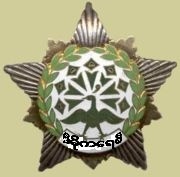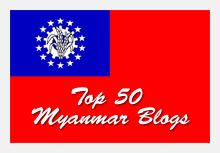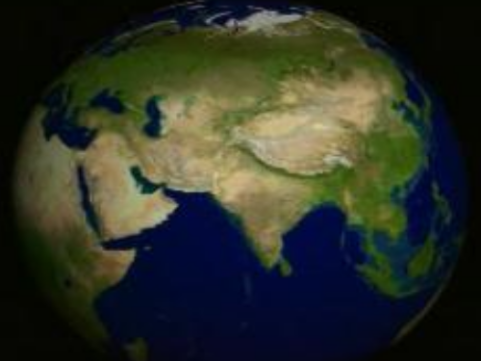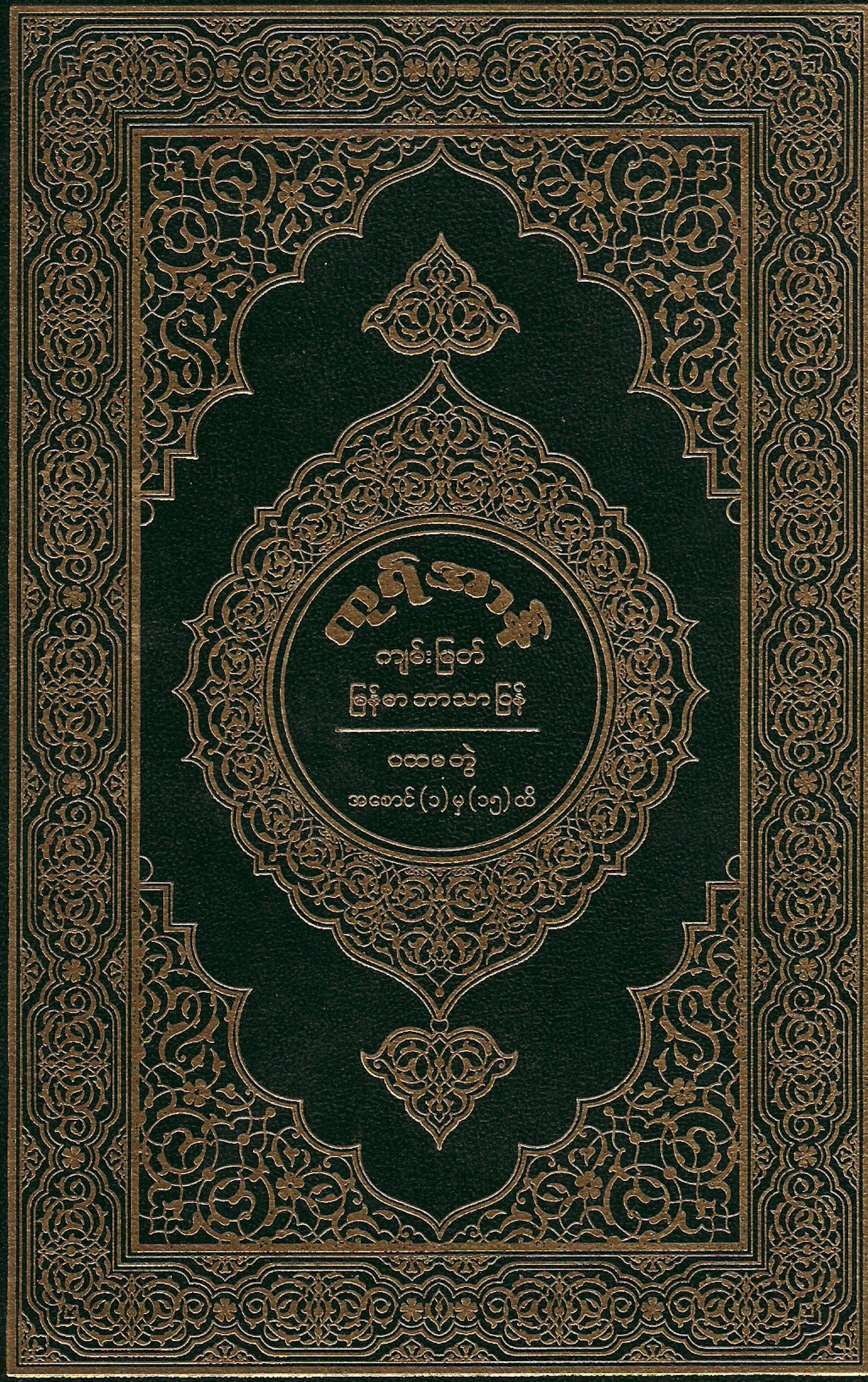Factors that influenced
the evolution of Burma Part IV
Pyu
Pyu, one of the three founding father of Bamar or Myanmar race was believed to be the mixture of three groups;
(i) Few insignificant local inhabitants since Stone Age, Bronze Age and Iron Age,
(ii) many migrants came from India bringing in Hinduism and Buddhism along with their cultures and literatures successively
(iii) and the last group believed to came down from north, Tibeto-Burman group.
Pyu language started in 5AD in Southern Rakhine.
The famous Mya Zedi Pagoda stone inscriptions were written in Pyu, Mon, Bama, and Pali in 1113AD.
-
Pyu had written records, dated from 1st century A.D.
-
and Mon from 5th century A.D.
-
and Bama had its own written records only in 11th century A.D.
Beikthano (Vishnu)
Beikthano (Vishnu) at the end of 4th. AD (9Khmer troops occupied 210-225 AD. (Taung Dwin Gyi) after which the Mons moved in, giving the cities names Panthwa and Ramanna pura. Religious remains show both forms of Buddhism, Mahayanism and Hinayanism, together with Vishnu worship. There are large stone Buddhist sculptures in relief in the Gupta style, bronze statuettes of Avalokitesvara, one of the three chief Mahayanist Bodhisattvas, and so many stone sculptures of Vishnu that the city was sometimes referred to as ‘Vishnu City’.
Pyu chronicles speak of a dynastic change in A.D. 94. Sri Ksetra village was apparently abandoned around A.D. 656 it was sacked by the Nan Cho Chinese Shan in the mid-9th century, ending the Pyu’s period of dominance.
Pyu Kings are Maharajas
In Chinese Chronicles they recorded Pyu as ‘P’aio’. But Pyu Called themselves Tircul..
-
There are records of Nan Cho and Tibet alliance in 755 AD to defeat Chinese.
-
Nan Cho king Ko-lo-fen communicate with Pyu. Pyu Kings were called Maharajas and Chief ministers were called Mahasinas.
-
Nan Cho conscripted Pyu soldiers to attack of Hanoi in 863 AD.
-
In 832 AD Nan Cho looted Han Lin village from Pyu.
Pyu kings named Vishnu as in Gupta, India
Inscriptions in Pyu language using a South Indian script, showed a Vikrama dynasty ruling there at least from AD 673 to 718.
-
On Pyu’s stone inscriptions, kings names with Vikrama were suffix with Vishnu. The same tradition was noticed in Gupta era India 100 BC. and in Sri Kestia, Mon in south, Thai and Cambodia.
-
Statue of Vishnu standing on Garuda with Lakshmi standing on the lotus on left.
-
And Brahma, Siva and Vishnu thrones were also found.
-
Name, Varman indicated that there was influence of Pallava of India.
-
The mentioning of Varman dynasty, an Indian name, indicated there was a neighbouring and rival city, but Old Prome is the only Pyu site so‘ far to be excavated in that area.
Indian Dravidian tribe in Panthwa
In Chinese Chronicles Chen Yi-Sein instead gives an Indian derivation for Panthwa village, as the name of a Dravidian tribe settled in Mon’s areas around the Gulf of Martaban. This group was later one of the pioneers in a ‘Monized’ occupation of Beikthano village, which also led to the village/city being called Ramanna-pura, linked to Mon areas of southern Myanmar (1999:77).
The Tagaung dynasty is explicitly incorporated into the story of Duttabaung’s mother and father; the lineage of the Queen of Beikthano is less consistent, but always intertwined with that of the Sri Kestra village rulers. In all of these, links are made between territorial control, royal patronage of Hindu or Buddhist sects and supernatural events.
Thamala and Wimala. Two princes named Thamala and Wimala (Myanmar version of Indian names-Thalma and Vimala.) established the town Bago in 573AD. Tabinshwehti (Taungoo Dynasty) conquered it in 1539 AD.
The evidence of the inscriptions, Luce warns us, shows that the Buddhism of Pagan ‘was mixed up with Hindu Brahmanic cults, Vaisnavism in particular.
Dear darling Nan,
Are you tired or fed up of reading my compassionate letters?
It is your prerogative, up to you to decide whether you continue to receive my letter or not. I will stop any time if you say so.
Kindly allow me to quote a famous saying, ‘My letters could not be written out unto their end even if all the trees on earth were pens, and if the sea eked out by seven seas were ink’.
May be my favourite song ‘Want to stay together, two of us only but no-one else’ by Mar Mar Aye could explain my feelings. She sang about using the sky to write upon, a river as the pen and using the ocean water as ink.
But in this age of ICT, neither do we need to use pens nor ink but just ‘typing’ onto the key board is enough. So I have to change or modified these into, “My letters could not finish even if my hands suffered ‘Carpel Tunnel Syndrome’.
Dear darling, do you still remember the day you showed me the news of the fossilized remains of rhinoceros and crocodiles found in the Pontaung Ponnya regions. Padalin cave paintings are the proof that there were early dwellers in late Old Stone Age Shwe Bama village. In the new Stone Age, stones were smoothly polished to make tools and were perforated to make beads. Fire was built. There were domestications of goat and sheep, buffalo and ox and later horse and elephant. As ploughing, sowing, reaping, threshing, pounding rice, cooking rice, weaving baskets, pottery making, spinning, weaving, carrying big stone from a very far place where it was available and lifting it up to the height where they want to place it, the practice of selling and buying came into being through barter system, etc. can be imagined.
Dear darling, I was heartened because formerly, we had nothing much about the Bronze Age found in Nyaungkan, lower Chin Dwin region up to confluence with Irrawaddy. At Mon Ywa (1500-1000 BC). There are nowadays evidence of our early Shwe Bama ancestors in Samon valley south of Mandalay, Taungthaman, Amarapura Iron age 460 BC, Pyu 200BC – 900 AD.Dear Nan, most of the historians try to visualize the human characteristics from their archaeological fossils. There were savages in the Old Stone Age from 400,000 to 8000 BC and barbarians in the new Stone Age from 8000 to 2000 BC. In our Shwe Bama village tract’s Iron Age or civilization began from 2000 BC because Iron Age was recognized as a civilized age in the history of the world.In 2500 BC, in U Kala’s village tract villagers in the Indus Valley wrote in cuneiforms which could not be decoded. Later in 1500 BC, Aryan came to India and they later started writing in Brahmi script. Since then, they have had records written in alphabets and people were taken as civilized in the history. Dear Nan lets go back to our topic today to the early Pagan village, which was our first Shwe Bama empire/village tract. There is a saying in Shwe Bama village, if we want to discuss or talk about Pagan village; ‘we need to be armed with sticks and knives or rather machetes.’ Yes there is no consensus about the history of Pagan village and every argument leads to controversy and used to end with a quarrel.
Dear Nan, now I am going into the mind field with the intention to challenge the nationalists with some radical views. I will start with Ah Yee Gyis or Aries, who were notoriously powerful in Pagan or Bagan village, before the Buddhist Religion arrived in our first Shwe Bama village. Nan, why did your face became red and try to gaze away from my letter. I know my wife, although you already got the grand children, you are still acting like a maiden. I would start a first salvo or bombardment with this fact. Ah Yee Gyis or Aries were related to one Indian sect or religion from Ko Kala’s village tract. The same Aris or Ah Yees from Ko Kala’s village were known for, swimming, martial arts, traditional medicine practice and the custom of sleeping with the brides on the first night of weddings.
I am not revealing some ‘blue stories’ or Thousand and one nights Arabian stories. I am not sure whether Ko Kalar Aries came physically here or their ‘religion’ or practice only arrived here. Never mind don’t worry dear, I just tease you with this story. Now I would like to trace our ancestors. I hope you already knew my habit of parroting or just informing you what I happened to know by chance. Sometime I just mentioned or write about anything I heard or read in the newspapers or books. All that I mentioned are not because I supported the idea or believed that it is an irrefutable truth. I just mentioned casually, sometimes light heartedly, sometimes as a joke to irritate you or sometimes just wish to highlight a controversy welcoming a heated debate in our platform or stage, this blog. In Burmese ‘Pwe sue aung_ loke thee’. I hope that then only more people will notice or read this Blog or there may be better hits on this web page. I already knew that this web page, is visited by Shwe Bamas abroad but I hope to see more progress. Dear darling that radical ideas came into my mind because I rarely have a chance to read any feed back from our readers. If we could even attract our oppositions and radicals, of course there must be decorum, mutual respect and some politeness from all the sides, to refute what we wrote; it may be a great progress. You had said before, “Counting the ballots is better than cracking the heads.”
Let me modify or think beyond that, or apply this to another area. I hereby wish to propose that, ‘we better fight with our pens rather than fighting with live ammunitions’. Fighting as a gentleman on the Internet is much better, more desirable and humane than fighting on the real battle field. Although I may be seen as a coward because of these words, after all the real battle ground is also not a level playing field for us. In the Shwe Bama village compound, anyone talking, speaking, writing or even possesses the papers against the SPDC or Daw Than Shwe would be arrested and prosecuted or more correctly persecuted.
Do you remember the famous case of a gentleman, a representative of few western countries, arrested for using the unregistered Fax Machine? (I wrote about him in previous letter.) And on the real battle front, at the border areas our freedom fighters are outnumbered. Their ammunition, transport, organization, intelligent networks and equipments, budget and etc. are also not able to compete with SPDC’s strong forces. Guerrilla warfare in the Shwe Bama village itself is also almost impossible. So we have only one easy option, ICT warfare or propaganda warfare on internet. And it is relatively safe and quite effective. But because of heavy censorship on Internet contents, it may be less effective inside the Shwe Bama village itself; until and unless those opposition radio stations actively promote and inform regularly on most of the opposition Internet contents. We are sad that there is some intense rivalry and competition every where among our various opposition groups. We should make all the articles bilingual, in Burmese for the general population, in English to attract and explain the foreigners to persuade them to support us. We need to translate all the information vice versa. I had seen a lot of second and third generations of our Shwe Bama Migrant’s children out of touch with our Shwe Bama language. Most of them could still speak fluently in Shwe Bama but could not read nor write in Shwe Bama well enough. Surprisingly most of them still love our Shwe Bama country, they care about our country and interested in all the things Shwe Bama. I hope if we could attract all of our people in the free outside world to participate in the open discussion, discourse, dialogue or even a heated argument, it would be beneficial for all of us as it could definitely lead to more mutual understanding.
Nan, thank you for the valuable advice you had secretly given to me. Because of your desire to promote unity through mutual understanding and reciprocal respect and of course, as this is the official aim of this blog. Do you notice that in my letters I purposely try to put in few controversial sensitive words or ideas against some of the groups. I just wish to increase their awareness, maturity and thank you for reminding ‘to stay colour blind’, that is against all kind of racial and religious discriminations. Please may you kindly understand me for provoking the radical ends of the spectrum like a rebel rousers in this letter and my future few letters. With each weekly letters I am probing more and more deeply into Shwe Bama village history. I hope our readers could judge and treat this blog as the one site of revolution that would sparks a thousand ideas. We all need ideas, not only moderate but even from the extreme end of the spectrum, we need all the possible views. Then we must judge or compare our notes with the universally accepted, UN recognized facts. All of us may not agree to all the facts but we have to make a consensus, and once the decisions are made, we all have to accept them as our guiding principle for the benefit of our beloved Shwe Bama country. Even if 95% of Shwe Bamas don’t get what we are writing…the remaining 5% who get it will definitely have an impact on our society.
I wish to present you with the wise advice of the Dalai Lama, our cousin Buddhist (Mahayana) leader. I told you in my very first letter that I even wish to spend my last days of my twilight years and like to even die in your Shan Land but when I have to change my wish now after I read Dalai Lama’s words which came out from his heart and vibrated right into my heart because of harmony of the feelings:“In Tibet, I would have been a prisoner, a puppet leader. But it doesn’t mean I ever forget about Tibet. I never stop thinking about it, and I tell the refugees that if they can, they must return one day or the Chinese will have won.” “But the Tibetans always say: wherever you feel most comfortable, that is your home. Whoever shows you greatest kindness and comfort, they are your family. So I am happy to die in India.”Although we all Shwe Bamas missed home, wish to return for retirement at old age or even die or wish to breathe the last breath at the homeland, most of us have no choice but to stay away from our beloved Shwe Bama Paradise for a long time.The wise religious leader continued:” You have bigger homes, yet smaller families. You have endless conveniences — yet you never seem to have any time. You can travel anywhere in the world, yet you don’t bother to cross the road to meet your neighbours,” he said. I think the Dalai Lama is right when he said that we don’t count our blessings and realize how much we truly have.“Too many people have given up on marriage. They don’t understand that it is about developing a mutual admiration of someone, a deep respect and trust and awareness of another human’s needs,” the Dalai Lama said. I think the Dalai Lama is right when he said that we don’t count our blessings and realize how much we truly have.
SPDC is going to ICC with four main charges: (1) being a threat to regional/international stability,(2) genocide, (3) drug trade and (4) nuclear ambitions. UN Security Council could take action urgently on SPDC regime. Nowadays many people and countries around the world want justice to be done by bringing SPDC generals to International Criminal Court in The Hague on these four charges. The choice is yours. If not, once you are going to be charged in the International Criminal Court of Justice in The Hague, you would know the grave consequences. And even if you could able to avoid that fate, acting like Hitler or Milosevic by deciding to die, you all should understand that once in the hereafter, you have to face the judgment of God or your Kamma. Even at The Hague, you could still show off your colour like Saddam Hussein or Milosevic by arguing your own case with an attack, but in the hereafter you could not argue anything if your deeds are already recorded in the dog-leather book of Tha Gyar Min. (Note: Don’t angry Nan, I understand that you have no connections with SPDC but I am 101% sure that once my letter was sent through Burma Digest, the SPDC spies would definitely ‘peek’ into the letter. And I wish to request those gentlemen to translate and give the full report to their Ah Ba Senior General Than Shwe so that he could review his latest condition or position at the edge of the Ah Thu Yar Gauge.) The facts that we wish to reveal to SPDC Generals are: This is the time to seek forgiveness, to repent, to regret, for salvation and for redemption. Instead of just releasing the fish and birds, release Daw Aung San Suu Kyi, U Tin Oo, U Khun Htun Oo and all the political prisoners. Instead of donating your ill gotten booties, give back the country you looted from the NLD and opposition. Instead of continuing governing Shwe Bama which is not yours and give back our independence. If not they would be charged soon in the International Criminal Court in The Hague on the crimes against humanity and genocide.If they still have some sense of dignity, they should bow to the discontented citizens and relinquish their posts.
Now the whole world knows that the SPDC Junta is trying to cheat the whole population of Myanmar, ASEAN, UN and the rest of the world. So we all wish and pray that the SPDC Generals would just repent, ask forgiveness from all the citizens including NLD Daw Aung San Suu Kyi, all the oppositions and prepare to retreat to the barracks, where they belong, according to the promise given by General Saw Maung, their previous leader before the election. Many of the top SPDC Junta leaders should go for retirement and spent their last precious time on earth with meditation and prayers.
Good-bye Yours loving other side
(Ko Tin Nwe)
BO AUNG DIN
See also_
- Basic factors that influenced the evolution of Burma Part I
- Factors that influenced the evolution of Burma Part II
- Factors that influenced the evolution of Burma Part III
- Factors that influenced the evolution of Burma Part IV
- Factors that influenced the evolution of Burma Part V
- Factors that influenced the evolution of Burma Part VI
- Factors that influenced the evolution of Burma Part VII
- The Golden days of the Great Mon Empire I
- Renascences of the Golden days of the Great Shan Empire
- The Golden days of the Great Shan Empire II
- The Golden days of the Great Shan Empire III
- The Golden days of the Great Shan Empire IV
- The Golden days of the Great Shan Empire V
- The Golden days of the Great Shan Empire VI
- The Golden days of the Great Shan Empire VII
Filed under: Beikthano, Buddhism, Chinese Chronicles, Hinayanism, Hindu, India, Khmer, Mons, Mya Zedi Pagoda, Nan Cho, Pyu, Rakhine, South Indian script, Sri Ksetra, stone inscriptions, Tagaung, Thamala, Varman dynasty, Vishnu, Wimala | Tagged: ASEAN, Beikthano, Brahman, Buddhism, Burma, CHINA, Chinese Chronicles, Ethnic Minorities, Gupta, Hinayanism, Hindu, History, India, Khmer, Mahayanism, Migration, Mons, Mya Zedi Pagoda, Myanmar, Nan Cho, Pyu, Rakhine, Shans, South Indian script, Sri Ksetra, stone inscriptions, Tagaung, Thailand, Thamala, Varman dynasty, Vishnu, Wimala | Leave a comment »












+(Small).jpg)

